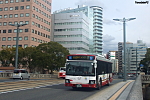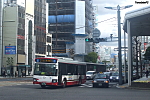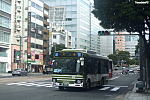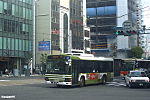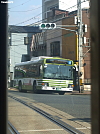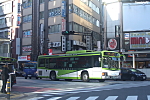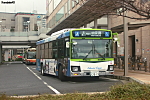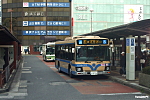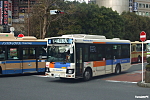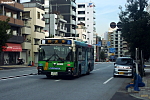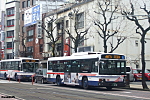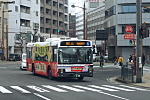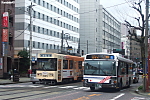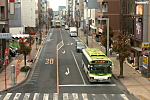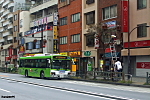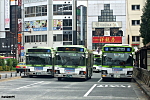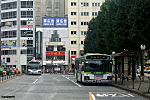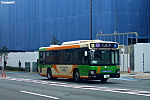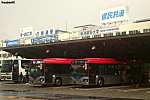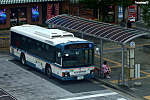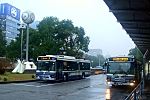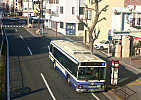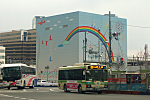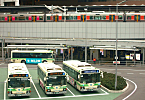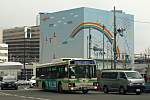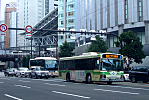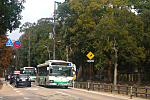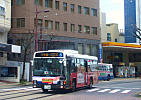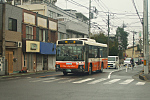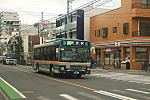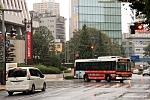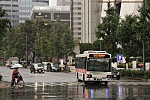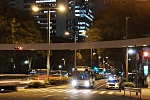Not logged in | Log in | Sign Up

Search Photos
Isuzu QDG-LV290N1 Erga Non-Step #240
14 february 2019 - Hiroshima, Inari-ōhashi (広島県広島市稲荷大橋).25: 広島駅 (Hiroshima-eki) → 井口車庫 (Inokuchi-shako)
If I am to believe Japanese Wikipedia, a portion of this company`s fleet is made up of used buses bought from the capital region. While the Erga in the photo is not one of those - having been bought brand new - it`s still curious as to why the Hiroshima-based company wasn`t seeking its fleet somewhere closer, for example in the Keihanshin area. On the other hand I`m under the impression that fleet replacement is going somewhat faster in the capital region, even if there isn`t really a push in Japan to operate low-floor only services.
Speaking of low-floor services, rte 25 is the only route of this company where departures scheduled to be operated by low-floor buses are marked. This is also particularly rare in Japan.


Author: TranslatorPS 

Isuzu QDG-LV290N1 Erga Non-Step #195
14 february 2019 - Hiroshima, Naka-ku, Ebisuchō (広島県広島市中区恵美須町).21-2: 広島駅 (Hiroshima-eki) → 広島港 (Hiroshima-minato)
To go along with the other photo, the typical version of rte 21 on its eastern half. The 八丁堀 Hatchōbori sheet doesn`t indicate a variation - all 21 trips go through this junction after all - but it`s more likely to serve to highlight that this route serves this major transfer point to begin with.


Author: TranslatorPS 

Hino SKG-KR290J2 Rainbow II #50544
14 february 2019 - Hiroshima, Naka-ku, Ebisuchō (広島県広島市中区恵美須町).4: 仁保車庫前 (Niho-shako-mae) → 県庁前 (Kenchō-mae)
This photo should make for a great example of the inconsistent marking of variations. There is a reason why I described the example of rte 4 as "good enough" under the last photo, and not completely good. The placard with "仁保南" (Niho-minami) seen on the driver`s console, alongside the top row of the LED scroll most likely, indicates a variation via the neighbourhood going by that name instead of taking a simplier route down the major roads. Travelling out of the city centre this variation is denoted as 4-2, as opposed to 4-1, but going inbound where there are only four stops in common before the route splits Hiroden isn`t messing around with a variation marker anymore. To make things even better, the route marked as a variation is done by about 60% of the departures from Niho garage.


Author: TranslatorPS 

Hino QKG-KV234N3 Blue Ribbon II #74834
14 february 2019 - Hiroshima, Naka-ku, Ebisuchō (広島県広島市中区恵美須町).2-2: 府中山田 (Fuchū-yamada) → 県庁前 (Kenchō-mae)
Hiroden uses a very peculiar route numbering system, which may be familiar to bus users in certain parts of the UK, or even better, Northern Ireland. Needless to say, bus and tram route numbers overlap, but that is no surprise to me. Most bus routes function as tree-like networks with a common route number - they depart from Hiroshima city centre along common routes that form the trunk of the tree, but sooner or later variations start splitting off like branches. To reduce the number of possible mistakes by passengers, individual variations are marked with an extra number after a hyphen. Therefore, on rte 2 seen in the photo it`s possible to see rtes 2, 2-1, 2-2, 2-5, 2-6, 2-7, 2-8, 2-9, and 2-12 on the scrolls. Where does the plain 2 with no suffix come in to this? More about this under the next photo.


Author: TranslatorPS 

Comments: 2
Isuzu QQG-LV234N3 Erga Hybrid #26766
13 february 2019 - Hiroshima, Minami-ku, Midori 1-chōme (広島県広島市南区緑1丁目).12-1: 東浄小学校前 (Tōjō-shōgakkō-mae) → 仁保沖町 (Niho-okimachi)
A slightly different shot - done very unexpectedly from on-board a rather older car on tram route 5. To wrap it up, some information about Hiroden`s bus network, but also the company itself. As of the end of March 2020, Hiroden operated a bus network of total route length of 1335.6 km using a fleet of 544 buses, carrying a daily average of 111 thousand passsengers. The entire company had 1780 employees at the time. Both of Hiroden`s transport branches are loss-incurring, as in fiscal 2019 Hiroden made a loss of 28 million yen on the tram network, equating nearly €216,000, and a loss of 1.075 billion yen on the bus network, or 8.29 million euro. Overall however the company is making profit (579 million yen in fiscal 2019, or 4.67 mln euro) due to its notably profitable housing development and renting business which easily makes up for the losses from its transport busieness - a model to be found not only at Hiroshima Dentetsu when it comes to Japan.


Author: TranslatorPS 

Hino 2SG-HL2ASBP Blue Ribbon Hybrid #64959
14 february 2019 - Hiroshima, Naka-ku, Hashimotochō (広島県広島市中区橋本町).3: 観音マリーナホップ (Kan`on Marina Hop) → 広島駅前 (Hiroshima-eki-mae)
I began a discussion about variation-marking suffixes as done by the bus section of Hiroden. What stood out was a plain rte 2 in the list of variations of that route. Where did it come from? The answer is simple enough, but perhaps irritating at the same time: Hiroden uses route numbers as simple as possible where common routings or common termini apply between variations. A good enough example of this is rte 4, where outbound departures are done as either 4-1, 4-2, or 4-3, but all inbound trips are operated scrolled as 4, despite different starting points. However, neither the "suffixes in one direction only" rule, nor the "each variation has a separate suffix" rule are applied universally (paradoxically there are as many inbound suffixes on rte 2 as outbound). Rte 3 in the photo is worthy of mention as there are no suffixes on this route, given that there are no route variations.


Author: TranslatorPS 

Isuzu PJ-LV234L1 Erga Non-Step #5132
7 january 2019 - Tōkyō, Toshima-ku, Nishi-ikebukuro 1-chōme (東京都豊島区西池袋1丁目), supposedly Metropolitan Route 441. The western side of Ikebukuro station is Kokusai Kōgyō`s lair, so to speak, as I had already shown before. The two buses displaying "out of service" are most likely only showing it to loop around the terminus located to the south of this intersection (behind the photographer). One of the buildings in the background houses a railway model shop, with prices easily able to make one doubt their wallet (but that`s railway modelling in general anyway).

Hino QPG-KV234L3 Blue Ribbon II Non-Step #5081
18 july 2019 - Niiza (Saitama Pref.), Tōhoku 2-chōme, bus terminus to the south of Shiki station (埼玉県新座市東北2丁目).志31 (shi-31): 新座団地 (Niiza-danchi) → 志木駅南口 (Shiki Station South Exit)
Route 志31 seen in the photo is operated together by Tōbu Bus and Seibu Bus, both companies deploying the service out of their respective Niiza garage. During most of the weekdays, the service operates every 10 to 12 minutes (with some gaps due to driver duty building), with the companies more or less alternating every other trip. The morning peak service sees departures 5 minutes apart, but even then the service requires only six buses. To make things more interesing, because every company sets up their own stop flag with their own information, it means that there are two versions of the route`s timetable at every stop, with each company carefully highlighting trips operated by the other as if it were a variation in routing.


Isuzu QPG-LV290N1 Erga Non-Step #3100
13 december 2018 - Shiki (Pref. Saitama), Honchō 5-chōme (埼玉県志木市本町5丁目), plac terminala autobusowego Shiki-eki Higashi-guchi.志05-3 (shi-05-3): 志木駅東口 (Shiki Station East Exit) → 中宗岡 (Naka-muneoka)
Pod zdjęciem 1064849 pada stwierdzenie, jakoby przewozy po japońskiej aglomeracji stołecznej to była głównie kwestia kolei. Sprostujmy więc lekko temat. Według statystyk podanych przez ministerstwo odpowiednie ds. transportu, w 2010 roku było 385 tys. użytkowników autobusowych biletów okresowych w aglomeracji stołecznej. Oczywiście przy dziennych 40 milionach pasażerów kolejowych oraz 8,5 milionach sprzedanych kolejowych biletów okresowych jest to naprawdę słaba liczba (ledwie niecały 1% użytkowników i prawie 4,5% posiadaczy), ale trzeba wziąć pod uwagę, że odsetek pasażerów korzystających z biletów okresowych w porównaniu do wszystkich jest zaskakująco niski (w 2010 r. w dojeździe do pracy 31% wszystkich pasażerów kontra 60% płacących z e-portmonetek). Kluczowy jest w tym fakt, że wiele dojeżdżających do pracy lub szkoły i jednocześnie korzystających z kolei dystans "ostatniej mili" pokonuje również innymi środkami, jak np. na rowerze (a ile mnie już takich prawie do szpitala zesłało!), czy też na piechotę. W porannym szczycie powszednim pomiędzy 70% a 95% korzystających z autobusów to dojeżdżający do pracy lub szkoły - liczba ta zmienia się zależnie od terminala autobusowego, natomiast ok. 60% wzwyż z tych osób korzysta z autobusów 5 dni w tygodniu, a ogólnie pasażerów regularnych (przynajmniej 2 dni w tygodniu) będzie pomiędzy 80% a 90%. Skalę autobusowych przewozów pasażerskich niech pokaże jednak jeszcze jedna kwestia, którą policzyłem już ja na podstawie informacji na stronach przewoźników. Wybrawszy z niemal setki przewoźników istniejących w aglomeracji tokijskiej kluczowe 18, tylko 14 z nich miało co prawda takową statystykę, ale te 14 firm razem wziętych posiadało na stanie, wliczając również pojazdy dalekobieżne - niespełna 11800 pojazdów. Obrazki więc jak ten wyżej - kilku ładujących pasażerów pojazdów, często wielu firm, są nie dość że uzasadnione, to bezsprzecznie częste... i potrzebne w funkcjonowaniu tego unikatowego organizmu. Brak angielskiego opisu celowy.

Author: TranslatorPS 

Comments: 6
Isuzu 2DG-LV290N2 Erga Non-Step #7-1826
25 january 2019 - Yokohama (Kanagawa Pref.), Nishi-ku, Minami-saiwai 1-chōme (神奈川県横浜市西区南幸1丁目), Yokohama-eki Nishi-guchi bus terminal.87: 横浜駅西口 (Yokohama Station West Exit) → 市民病院 (City Hospital) → 横浜駅西口 (Yokohama Station West Exit) (circular route)
Is this a normal route number? Yes! Yokohama City Bureau of Transportation does NOT use kanji characters in its route numbering. The number and scale of bus operations in Yokohama is slightly mind-numbing, but one way or another you got to somehow cover a 3.73 million population city, which aside from its metric ton of standard-length buses (!!) otherwise only relies on JR, Keikyū, Tōkyū, Sōtetsu, and its own two subway lines. A bit of interesting trivia about Yokohama: as an administrative unit, Yokohama-shi is the most populous city in Japan, however that`s not the case as a general urban unit, in which case it places second - if we can even consider the possibility of splitting out anyting in the wider Kantō agglomeration aside from arbitrary borders.


Author: TranslatorPS 

Comments: 2
Isuzu SKG-LR290J2 Erga Mio Non-Step #5759
25 january 2019 - Yokohama (Kanagawa Pref.), Nishi-ku, Minami-saiwai 1-chōme (神奈川県横浜市西区南幸1丁目), Yokohama-eki Nishi-guchi bus terminal.浜4 (hama-4): 保土ヶ谷駅東口 (Hodogaya Station East Exit) → 横浜駅西口 (Yokohama Station West Exit)
If anyone of you thinks that I`m going to run out of Japanese bus operators, they`re getting closer and closer to the mark. Sōtetsu Bus is closely related to the railway with the same name, which currently operates three lines, with the main terminal some 200 metres behind me. The bus operations area is closely related with the railway service area. The most curious thing of all is however the route number - although the kanji+number scheme is nothing new in the Tōkyō agglomeration, what is new is the kanji character being selected not from, for example, the nearest railway station, but... the operating garage! As a side effect there is a plethora of 旭 (asahi) routes without a single railway station in the area using this character (two of these terminate here anyway).


Author: TranslatorPS 

Comments: 4
Hino PJ-KV234L1 Blue Ribbon II Non-Step #P-N323
25 december 2018 - Tōkyō, Bunkyō-ku, Ōtsuka 3-chōme (東京都文京区大塚3丁目), Metropolitan Route 437. Here`s a Christmas Blue Ribbon two years later. 25 December 2018 was a Tuesday, so Japanese transport companies operated a regular Monday-Friday schedule. Nevertheless not even a Saturday or Sunday schedule (for which there is no reason on December 25th unless it just falls on the appropriate weekday) would stop routes 学01 and 学07 (gaku-01 and gaku-07) from operating. They are two circular routes connecting the prestigious University of Tōkyō campus with nearby railway stations. I`m only mentioning these routes mostly because apart from 都02 (to-02) they are the only other options that this bus could be pulling out onto.

Isuzu PJ-LV234N1 Erga Non-Step #2604
11 february 2019 - Nagasaki (Nagasaki Pref.), Dōzamachi (長崎県長崎市銅座町). Putting aside how much I had to look for this place on Google Maps, this company has a really strange approach to passenger information. The number seen on the destination display doesn`t indicate the route as much as the destination area, or sometimes the route taken. Thus when using the stop timetables (which I already mentioned briefly under photo 1010960) one has to search for their route by the terminus name and then by the via points. The 20 seen in the photo is first the Ebira Line (江平線) towards the city centre, and second a very summary-like description of anything terminating at the Nagasaki Shinchi Terminal, or Chūō-bashi (Central Bridge). Well, the result is that timetables near the city centre look more like this...

Author: TranslatorPS 

Comments: 2
Isuzu PJ-LV234N1 Erga Non-Step #2715
11 february 2019 - Nagasaki (Pref. Nagasaki), Shinchimachi (長崎県長崎市新地町). A little complaining from me, but not unjustified complaining. However the route numbers of Nagasaki trams may make sense (daytime 1, 3, 4, 5, one lap as a 2, and unnumbered extra trips), I have no doubt that buses are simply asking to be reorganized, or rather have a normal system introduced. However, what am I expecting from a company that has a grid of green lines with bus stops marked for a network map, with no information on actual routes?

Author: TranslatorPS 

Isuzu Erga #2902
11 february 2019 - Nagasaki (Nagasaki Pref.), Dejimamachi (長崎県長崎市出島町). A 100 scroll set like this could honestly be any route operated by Yanagai depot (the bus belongs to it is what I`m implying here). To the left is 1503 with the tram depot on a white scroll, indicating one of the extra workings done along route 1 between Urakawa-shako and Shinchi-chūkagai. No idea where everything goes, but the locals seem to know what`s happening.

Author: TranslatorPS 

Isuzu PKG-LV234L2 Erga Non-Step #5221
13 december 2018 - Shiki (Saitama Pref.), Honchō 5-chōme (埼玉県志木市本町5丁目), Prefectural Route 244. Now that I mentioned it, Saitama 244 is probably one of the shortest numbered roads in Japan, at only 855 metres.志05 (shi-05): 志木駅東口 (Shiki Station East Exit) → 宗岡 (Muneoka) → 志木駅東口 (Shiki Station East Exit) (circular route)
5221 is finishing its lap on the circular route 志05. The route connects Shiki Station with the low-density residential areas of Muneoka in northern half of the city, close to Arakawa and just short of the border with Saitama city. The route operates as a circular around the core of these residential areas, both clockwise and anti-clockwise. Amusingly enough, for Japan`s love of splitting out variations as separate route numbers, the two directions carry the same route number - it`s only trips cut short that have off-shoots.


Author: TranslatorPS 

Comments: 2
Isuzu QPG-LV234L3 Erga Non-Step #5457
8 october 2018 - Tōkyō, Toshima-ku, Ikebukuro 2-chōme (東京都豊島区池袋2丁目), Metropolitan Route 441.池21 (ike-21): 高島平駅 (Takashimadaira Station) → 池袋駅西口 (Ikebukuro Station West Exit)
This 池21 trip, operated by Ikebukuro depot this time, is nearing its end - after this stop, which doesn`t even have a timetable on Google Maps, all that is left is the Ikebukuro terminus. The advert carried is for a popular brand of green tea sold in plastic bottles and available in the vast majority of vending machines (and by extension, of shops). Despite the high number of buses passing through here, photography is made difficult by cars parking almost anywhere and the omnipresent little barriers.


Isuzu KL-LV280L1 Erga Non-Step #5023
16 october 2018 - Tōkyō, Toshima-ku, Nishi-ikebukuro 1-chōme (東京都豊島区西池袋1丁目), Ikebukuro-eki Nishi-guchi bus terminal main section. This terminal is dominated by Kokusai Kōgyō and its frequent connections. The following routes start here after all: 池02, 池03, 池04, 池05, 池11, 池20, 池20-2, 池21, and 池80 which runs to the depot (池 = ike). Route 池07 also appears here for its intermediate stop. All of the routes mentioned are operated by the nearby Ikebukuro depot, although 池20 and 池21 are operated jointly with Shimura depot, and the 池11 with Kantō Bus. Not all routes actually start service from stops in or near this shot, but due to the road and stop layout all of them at least turn around through here. Aside from typically city routes, there are also departures of the night bus parodies and the express airport buses from here. The latter is more so curious as one can get from Ikebukuro by rail to both key Tōkyō airports with one transfer at most (for Haneda via Yamanote and Keikyū lines transferring at Shinagawa; for Narita via Yamanote and Keisei lines transferring at Nippori), and even without transfers to Narita... and it would definitely be faster than by road, but nevertheless there is...was interest.

Comments: 4
Isuzu KL-LV280L1 Erga Non-Step #5037
16 october 2018 - Tōkyō, Toshima-ku, Nishi-ikebukuro 1-chōme (東京都豊島区西池袋1丁目), Ikebukuro-eki Nishi-guchi bus terminal main section.池21 (ike-21): 池袋駅西口 (Ikebukuro Station West Exit) → 高島平駅 (Takashimadaira Station)
Now that we are outside of the Yamanote line loop (and outside the Akabane, or rather Saikyō line axis), the number of buses operated by the metropolitan government drops a lot, even though there is still over 8 km left until the border of the 23 wards. Instead, bus transport in this area is dominated by an array of private companies, oftentimes associated with the private railway operators which have their lines or terminals nearby. Kokusai Kōgyō is an exception here - the company is not associated with any railway, despite a brief stint with Dai-tōkyū in the 1940s, as historically it was formed from mergers and splits of various private carriers in the Itabashi and Akabane areas. The operator currently has 10 garages spread around Tōkyō and Saitama prefecture. However logical it may be that the company spread out towards Saitama city (more or less along the already mentioned Saikyō line), its Hannō depot, detached from everything else, is quite curious (albeit historically justified), being in a typically Seibu area and what not.


Isuzu 2DG-LV290N2 Erga Non-Step #P-D302
25 december 2018 - Tōkyō, Bunkyō-ku, Ōtsuka 2-chōme (東京都文京区大塚2丁目), National Route 254.都02 (to-02): 錦糸町駅前 (Kinshichō Station) → 大塚駅前 (Ōtsuka Station)
Today`s topic is a short series of Toei buses. I think it would be worthwhile to explain what Toei actually is. It is in fact a section (bureau) of the metropolitan government of Tōkyō. To lay it over British terms, it`s as if the Greater London Assembly planned and operated the bus services directly using its own buses and hiring its own drivers (not even with TfL, but literally as an office out of the GLA). When referring to the Tōkyō metropolis it`s important to note that I`m referring to the prefectural-level body - Tōkyō city as a local government body ceased to exist in 1943. Perhaps it`s a slightly strange arrangement, but Japan just about doesn`t have tendering and contracting processes in public transport (at least as far as I know) - it`s either one of the 28 local government transport bureaus, or private operators, which are one way or another often tied to one of the railway conglomerates.


Isuzu QDG-LV290N1 Erga Non-Step #R-B771
14 september 2018 - Tōkyō, Edogawa-ku, Naka-kasai 5-chōme (東京都江戸川区中葛西5丁目), bus terminus adjacent to Kasai metro station.秋26 (aki-26): 葛西駅前 (Kasai Station) → 秋葉原駅前 (Akihabara Station)
Apparently you can get to Akihabara on this bus. So far, true, but whether this thing`s got a set frequency is another story. Mondays to Fridays it sports a solid morning peak at every 6-10 minutes, interpeak at every 26-28, and an afternoon peak at every 19-21, or maybe 15-16. On Saturdays it runs apparently every 19-21 minutes in the morning, but later every 23-24. Only on Sundays does it run every 20 minutes for most of the day. What of it, however, if the last departures are before 10pm? That`s how most more frequent city bus routes look like in Japan: most companies don`t know what a set frequency is, never mind synchronisation modules, and above all, departures after 22:30 are rare beyond rare.


Isuzu 2PG-LV290Q2 Erga Non-Step #H1127-I
30 december 2018 - Niigata (Niigata Pref.), Chūō-ku, Hanazono 1-chōme, bus station located in front of Niigata railway station (新潟県新潟市中央区花園1丁目).C31: 新潟駅前 (Niigata Station) → 西部営業所 (Seibu Depot)
Back to Niigata we go... Two Ergas (titular and H1047-I on rte W22) and another I-have-no-idea-what-it-is are loading passengers at the stands of Niigata-eki-mae bus stop. As seen in the photo, the buses are reversed into the stand entrances, which is good in terms of pulling out from the station, as well as given that passengers board via the back doors.
The bus network is built such that routes that operate mostly within the city terminate here. However, routes that operate outside of the built-up areas but still operated with city buses serve this stop en-route. Since they serve these reverse-entry stands, buses arriving here reverse in service with passengers on-board. However, staff on-site assist with the reversing process; they are also the ones to permit pax to enter the stand area. I don`t have any photos worth publishing from the reversing itself, however. The snow comes as a bonus.


Author: TranslatorPS 

Comments: 1
Isuzu QQG-LV234L3 Erga Hybrid Non-Step #E165
14 september 2018 - Tōkyō, Edogawa-ku, Naka-kasai 5-chōme (東京都江戸川区中葛西5丁目), bus terminal adjacent to Kasai metro station. I wasn`t in Japan for even two weeks at that point, but I made use of the still free days, and I went to the annoyingly located Tokyo Metro museum. I recommend it by all means - for an acceptably priced ticket of 200 yen (approx. €1.50) one can (try to) learn the history of Tokyo`s subways, their methods of construction, methods of power, or make attempts at a number of simulators.Keisei Bus operates a wide network of bus services to the east of Tōkyō, reaching as far as Chiba. In the Tōkyō area itself they`re biting into Toei and Tōbu areas.


Author: TranslatorPS 

Hino PKG-KV234N2 Blue Ribbon II Non-Step #NH-259
19 february 2019 - Nagoya (Aichi Pref.), Naka-ku, Sakae 3-chōme (愛知県名古屋市中区栄3丁目), one of the multiple parts of the bus terminal adjacent to Sakae metro station. On the second day of my stay in Nagoya, the weather went downhill altogether - it was the only day so bad during my 10 days of wandering halway across the country. Nagoya`s city buses use the typical route numbering scheme, that is, a kanji character and some number. Noticeably however, Nagoya is not afraid to use two characters (see NH-264 to the right on rte 高速1 or my previous photo of NH-144), which is for example rather rare in Tokyo if it`s not the Latin alphabet. I only used the buses a few sparse times, using the subway more to move around the city. The municipal operator has a flat fare, and thus passengers board at the front.

Author: TranslatorPS 

Comments: 10
Hino QPG-KV234N3 Blue Ribbon II Non-Step #1365
19 february 2020 - Nisshin (Aichi Pref.), Akaike 1-chōme (愛知県日進市赤池1丁目), near Akaike station. Akaike is a through-operations border station - Nagoya Subway Tsurumai Line ends here, and Meitetsu Toyota Line starts here, and mutual through-operations take place here. Not too far are the Nisshin metro depot and Nagoya City Tram and Subway Museum. In the background, 1386 on rte either 46 or 47.In contrast with the previous shot from the city hall, here I was able to at least deduce the route number from the digitless scroll. Routes 51 and 53 form an alternative route to Meitetsu Toyota Line between Akaike Station here and Toyota city centre. And yes, it`s the same Toyota City where the car manufacturer by the same name is headquartered. The conglomerate`s name was not a result of the city name by any means however - quite the opposite, it was Koromo-shi in 1959 that took on the name of the manufacturer that was established in 1937.
This photo is the last from the core of my 10-day trip across half of Japan that took place in February 2019. Any further photos from the Land of the Rising Sun will be perhaps filling in gaps from this trip, or photos from areas closer to my then-home around Tōkyō.


Author: TranslatorPS 

Hino PJ-KV234N1 Blue Ribbon II None-Step #NH-144
18 february 2019 - Nagoya (Aichi Pref.), Nishi-ku, Nagono 2-chōme (愛知県名古屋市西区那古野2丁目). Some 16 months after the trip itself I finally got around to photos from Nagoya. I don`t have anything from the subway, considering that the network itself is not really good for photography. To start off a few shots of the municipal operator - much like in Tōkyō, Nagoya has a Transport Bureau attached to the city hall. Worth nothing is that there are 26 local administration units with such a Transport Bureau, most often called kōtsu-kyoku like here.

Author: TranslatorPS 

Hino PDG-KR234J2 Rainbow II Non-Step #39-1305
17 february 2019 - Ōsaka, Kita-ku, Umeda 3-chōme (大阪府大阪市北区梅田3丁目). Since a comment from @empi asked for a Hino Rainbow in front of the rainbow, I will not fail to deliver! I was afraid the photo wouldn`t be good enough for publication, but I managed something out of it - even though it wouldn`t hurt if it was a bit more focused.To the left, JR West`s 641-15930 (なにわ200か19-85), a 2015 Isuzu Gala.


Author: TranslatorPS 

Hino PDG-KR234J2 Rainbow II Non-Step #39-1305
17 february 2019 - Ōsaka, Kita-ku, Umeda 3-chōme (大阪府大阪市北区梅田3丁目), Ōsakaeki-mae (大阪駅前) bus terminal. Once again it`s 39-1305, but simply because it`s the best seen bus here. One of the indispensable elements of Japanese bus networks is these small bus terminals located at railway stations. In this case 21 different routes depart from here. Aside from the titular bus we also have: to the left on rte 97 20-2866, a 2010 Isuzu Erga, to the right on rte 36 36-0806, a 2006 Hino Blue Ribbon II, and in the background on rte either 8 or 53 39-1307, a 2009 Hino Rainbow II. One will notice that they are barely any different from each other - after all, Hino Rainbow is merely a rebranded Isuzu Erga. To finish off, above all of them is an eight-car JR West 323 series set.

Author: TranslatorPS 

Hino PJ-KV234L1 Blue Ribbon II Non-Step #36-0803
17 february 2019 - Ōsaka, Kita-ku, Umeda 3-chōme (大阪府大阪市北区梅田3丁目), right beside Ōsaka (JR) and Umeda (back then still, currently Ōsaka-Umeda - private railways) railway stations. The topic of Latinization of public transport information in Japan is as broad as the archipelago itself. In the Tōkyō area it`s pretty much an obligatory element on the vehicles, and it`s quite similar in Kyōto. Other areas of the country are quite varying. The scrolls here are likely to remember the bus` introduction into service in 2006, so I`m not overly surprised by the lack of Latin transciption (Itakano-shako, or Itakano Depot, for those curious). However, one should expect even less Latin transcriptions at bus stops, but even that will depend on the area and the company.

Author: TranslatorPS 

Comments: 3
Isuzu PDG-LV234L2 Erga Non-Step #20-2859
16 february 2019 - Ōsaka, Kita-ku, Ōfukachō (大阪府大阪市北区大深町), National Route 176. I spent the most time in Ōsaka during my ten-night long journey - a whole three nights. It was also the only city that I reached without using any Shinkansens - I decided that the conventional railway offer was more than satisfactory for just fraction of the price.I`m not entirely sure what is happening with the city buses in Ōsaka. The city department finished their operations on 31 March 2018 and since then the entire network has been operated by a supposedly private, but not really private company. Its shareholders are Ōsaka City and Ōsaka Metro Co., Ltd., or rather, also Ōsaka City.
Completely unrelated, but route 34 seen in the photo was 214.5 mln yen in the black in year 2006 (about 1.83 mln euro by today`s exchange rates), and so it was on top of the rankings in the back then municipal operator`s records.


Author: TranslatorPS 

Comments: 2
Hino LKG-KV234N3 Blue Ribbon II Non-Step #奈良200か724
16 february 2019 - Nara (Nara Pref.), Kasuganochō (奈良県奈良市春日野町), or something like that. Nara is known for its deer walking around the area surrounding the temples, which happily accept special wafers from tourists` hands, however risky it may be for sometimes they try to eat the entire tourist (ekhm). As for the bus, I have completely no idea what it`s meant to be running as (there are some 11 routes operating along that street). It definitely won`t be one of the mutually countered circular routes 1 and 2 that operate around Nara`s city centre.

Isuzu 2PG-LV290N2 Erga Non-Step #A8-726
16 may 2019 - Niiza (Saitama Pref.), Higashi 2-chōme (埼玉県新座市東2丁目), Prefectural Route 40, at around Rikkyō-mae stop.清61 (kiyo-61): 志木駅南口 (Shiki Station South Exit) → 清瀬駅北口 (Kiyose Station North Exit)
This photo may seem random, but it`s mostly for the sake of trivia. For the first time in 67 years, Seibu Bus is changing its route bus livery. You can see the new template at these URLs: sides, front and back. I dare say it`s nothing more than the sprayman`s nightmare, but I imagine they have already come up with a solution for that. The paintjob needs the refreshment (the current template is showing its age), and you can also see the grey and blue which have recently dominated the mother company`s rail stock.


Author: TranslatorPS 

Isuzu QKG-LV234L3 Erga Non-Step #広島200か17-78
14 february 2019 - Hiroshima (Hiroshima Pref.), Naka-ku, Hashimotochō (広島県広島市中区橋本町). I did not delve deep into the bus network details during my stay in Hiroshima, mostly because I was focusing on the tramway network instead. I did note three main bus operators, however. One positive point for Hiroshima is a somewhat more normal bus route numbering system, without kanji characters.

Author: TranslatorPS 

Place: 広島市 [Hiroshima-shi] (Hiroshima-ken)
| Owner: GeiyoBus 東広島市 [Higashihiroshima-shi] | Route: 40-1
Isuzu QPG-LV234N3 Erga Non-Step #1584
11 february 2019 - Nagasaki (Nagasaki Pref.), Dejimamachi (長崎県長崎市出島町). A Japanese city bus operator without an Isuzu Erga? I probably mentioned it, but it`s like a British operator without an ADL.Nagasaki city buses irritated me with their lack of Latin transcription on the scrolls - something I`d only seen in Kōbe other than here. On top of that, the timetables on stops were done in the "one table for all routes" style with the different variations in separate rows - without knowing the city I could only be guessing where goes what, given the lack of any route diagrams on the stops, something that`s a blessed standard elsewhere in the country.


Author: TranslatorPS 

Isuzu PDG-LR234J2 Erga Mio Non-Step #421-7961
6 february 2019 - Sapporo (Hokkaidō), Chūō-ku, Miyanomori 2-jō 16-chōme, near Ōkurayama kyōgijō iriguchi bus stop (北海道札幌市中央区宮の森2条16丁目). For those interested in seeing the Sapporo Olympic Museum, or perhaps the Ōkurayama ski jump, I recommend the 円14 (maru-14) bus departing from 円山公園 Maruyamakōen metro station. For I believe 210 yen the bus takes a short while to reach the stop around where the photo was taken, from where all that`s left is another 10-15 minute climb to the ski jump itself. What`s slightly amusing is the route`s timetable: in the inter-peak it runs every 20-40 minutes, and there`s no point in looking for something else it might be coordinated with, because there just isn`t anything.

Author: TranslatorPS 

Isuzu KL-LV280Q1 Erga One-Step #札幌200か15-04
7 february 2019 - Sapporo (Hokkaidō), Chūō-ku, Kita 1-jō Nishi 3-chōme (北海道札幌市中央区北1条西3丁目). I`m not sure why, but walking around central Sapporo I felt as if I was walking around Manhattan... not that I had ever been to the latter.

Author: TranslatorPS 

Comments: 2
Isuzu LKG-LV234N3 Erga Non-Step #H716-I
30 december 2018 - Niigata (Niigata Pref.), Chūō-ku, Hanazono 1-chōme, Niigata station northside front (新潟県新潟市中央区花園1丁目).C20: 新潟駅前 (Niigata Station) → 西部営業所 (Seibu Depot)
Last time, I presented a few buses from Sado island. This time around however I`ll be showing some shots from Niigata itself, the capital of the prefecture by the same name. Niigata is a port city, one of a few sea gates towards Korea, north China, and Russia. Inhabited by some 810 thousand, the first mention of its name come from 1520. The Niigata port was one of the five that were to be first opened to international traffic in 1858 after the first international agreements that were to open Japan to the world after 250 years of closing itself off. One of the characteristic features of the city up until the second half of the previous century was the network of canals, the layout of which forms part of the current street network. Nowadays Niigata is mostly a rular-oriented city - it`s famous for the highest quality white rice across the country, for example. From a tourist`s point of view, I found it just slightly surprising to see tourist information provided in... Russian, although it makes sense given the city`s location.


Author: TranslatorPS 

Isuzu KL-LV280L1 Erga Non-Step #H1068-I
29 december 2018 - Sado Island (Niigata Prefecture), Aikawa, Sado-shi Aikawa-shisho terminus (新潟県佐渡市相川).I had to dig through tender paperwork from when Yokohama-shi Kōtsūkyoku were selling this bus in order to fill in the data. Thankfully everything was there, if not more.
Sado Island. The sixth biggest island of Japan, counting the four main islands and Okinawa, and not counting territories disputed with the Russian Federation. The population stands at almost 55,000. In times gone past, the island had two purposes: it was the place of exile for the less politically comfortable (the only punishment worse than exile in Sado at the time was death itself), and then a gold mine was established here. The gold dug here pumped a large portion of the Tokugawa shogunate economy. At its best, the island was inhabited by approx. 122 thousand people. Now the island shares the nationwide problem of aging population. Coupled with the lack of third level education, many young people are left with little choice and simply enough just leave.


Comments: 6
Hino PJ-KV234L1 Blue Ribbon II One-Step #9857
6 december 2018 - Niiza (Saitama Pref.), Tōhoku 2-chōme (埼玉県新座市東北2丁目), Prefectural Route 40. Here you can see a typical city bus layout when it comes to Japan - a dual-door standard bus, in recent years more likely than not on a low-entry chassis. The two doors are segregated: one is for entry, the other for exit. However, there is no strict rule defining which door will have which purpose. In the Tōkyō general area it depends on when the fare is paid: if it`s a flat fare paid when getting on, board at the front, if it`s a distance-based fare paid when getting off, board at the middle. Thus Kyōto surprised me as, despite a flat fare, one pays when getting off, so the boarding is through the middle door.

Comments: 7
Isuzu PKG-LV234L2 Erga Non-Step #6909
13 december 2018 - Shiki (Saitama Pref.), Honchō 5-chōme, Shiki-eki Higashi-guchi terminus (埼玉県志木市本町5丁目).志05 (shi-05): 志木駅東口 (Shiki Station East Exit) → 宗岡 (Muneoka) → 志木駅東口 (Shiki Station East Exit) (linia okólna)
This is the third photo within a kilometre of each other now, and a third bus company. When it comes to integration, Europe is like a heaven. It`s impossible to see ticket unions here (with minor exceptions regarding day tickets, like in Kyōto). On-stop passenger information usually leads to a forest of stops, as each operator places their own flags and schedules, although oddly enough termini are well integrated. As for the Internet, most companes refer over to nation-wide search engines, such as Navitime, but even then often to separate subpages that only cover their own services. Most trips are paid on a trip by trip basis, and because of long-term tickets - commuter passes as they`re referred to here - it`s impossible to find network-wide tickets spanning over multiple operators. There are, however, routes operated by two operators simultaneously, surprisingly enough, and in those cases one can actually buy a commuter pass covering both operators on that route. The cherry on top of the icing lays in the network maps on board the buses which show... only the routes operated by that particular garage.


Author: TranslatorPS 

Comments: 1
Isuzu QDG-LV290N1 Erga Non-Step #A6-954
13 december 2018 - Niiza City (Saitama Pref.), Tōhoku 2-chōme (埼玉県新座市東北2丁目), Prefectural Route 40. With that said, I`d like to say hello :) I hope to add worthwhile content to this photogallery.志33-1 (shi-33-1): 志木駅南口 (Shiki Station South Exit) → 新座駅南口 (Niiza Station South Exit)
With this photo, I think I can summarise the essence of Japanese suburbs quite well: not the widest streets (sidewalk not compulsory), completely mixed high-rise and low buildings, mandatory kombini in a relatively accessible distance (here: 7-Eleven), wiring out in the open, at least a few bicycles within eye`s reach, and along the afore-mentioned street a local city buses passes quite regularly (or not), whose purpose is a feeder to the closest railway station or stop. Sleepertown, no more, no less.


Author: TranslatorPS 

Comments: 5
